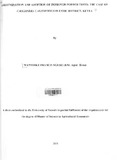| dc.description.abstract | This study assessed the effectiveness of different extension methods in reaching farmers in different gender categories of dairy farms to inform them about Calliandra calothyrsus fodder trees technology and also factors determining adoption. Data was collected on 300 randomly selected farm households in Embu. The sample households were gender disaggregated at two levels, first, according to the gender of the household head and then on the basis of gender of dairy enterprise manager. Based on gender of the household head, male-headed households (MHH) and female-headed households (FHH) were distinguished. Household categories by gender of the dairy enterprise manager comprised of male managed farms (MMF), female managed farms (FMF), and jointly managed farms (JMF). Descriptive statistics were used to in the assessment of the effectiveness of dissemination methods while for adoption analysis, Tobit analysis was used. Recommendations were then made on how calliandra dissemination and adoption can be enhanced.
Use of formal methods of extension (on farm trials, farm visits, field days and demonstrations) was ineffective in reaching many farmers and was often biased against women. Field days and demonstrations where information on calliandra was disseminated had reached the highest number of farmers, which was only 19 percent. Only 8 percent of farmers in the FHH had attended field days and demonstrations compared to 20 percent in MHH. It was also found that during farm visits extension agents often delivered messages about the technology to men alone even in cases where dairy was co-managed by husband and wife. Although only a few sample farms had participated in the on-farm trials on
calliandra (3 percent) none of them was a FHH. Use of women groups enabled relatively
more women to be reached but the groups lacked modalities on production of own calliandra planting materials (seedlings) as initially intended.
Only 16 percent of farmers grew calliandra and the mean number of trees per adopter household was only 80 trees. Less of the FHH (11 percent) than MHH (17 percent) had calliandra. Adopter FMF and JMF had less trees (40 and 35 respectively) compared to JMF (120 trees). Adoption was significantly and positively influenced by perception that calliandra could enhance productivity, access to extension, and participation in on-farm trials.. While lack of a milk market has become an important problem in Embu District following the collapse of the Kenya Co-operative Creameries (KCC), Tobit results using observations for all farmers showed that calliandra adoption increased with the proportion of milk produced that the farmers were able to sell.
From these findings the following recommendations were made: (a) Calliandra dissemination through extension functions such as group demonstrations and extension visits should be intensified because this has a positive impact on adoption. (b)The bias against women in the conventional extension methods should also be addressed though use of methods that are more effective in reaching the women (e.g. use of women groups), including women in farm trials on the technology, ensuring that extension activities are always held in times and places convenient for women to attend and training and encouraging extension agents to convey extension messages to both men and women during farm visits. (c)The extension message should have empirical evidence showing the contribution of calliandra to productivity so as to favourably influence farmers’ perception about this and thereby foster adoption, (d) Efficient milk marketing channels should also be developed in the district. | en_US |



